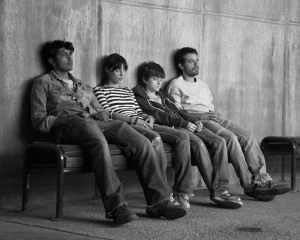 Review: One Screening Only
Review: One Screening Only
Güeros | Alonso Ruizpalacios | Mexico | 2014 | 108 minutes
WUD Marquee Film Festival, Union South Marquee Theater, Saturday, November 14, 2:00pm»
I had an interesting but unfortunate experience with Alonso Ruizpalacios’s Güeros when it played at the Wisconsin Film Festival back in April. In the middle of attempting a 5-film day, I came down with a fever that seriously hindered my ability to watch films that require a degree of concentration. (Curiously, I rebounded enough that night to enjoy Free Fall, one of my favorites of the Festival.) Luckily, the WUD Film Marquee Film Festival provides an opportunity for me to revisit Güeros, which is also currently streaming on Netflix.
Broadly speaking, most of what I remember liking about the film the first time, especially its vivid black-and-white cinematography, remains worthy of discussion and praise. What I had difficulty with the first time, it’s loose episodic structure and lack of narrative momentum, had more to do with my fever-induced lack of focus. Once you understand its structure, and allow the film to flow rather than fit it into a 3-act box, you should enjoy it more than I did the first time.
The film opens with a sequence that exemplifies its often-used strategy of misdirection; you’re never quite sure which narrative detail will be the most important until shortly later (which, again, is hard to handle with a fever). After an opening shot of a hand selecting a water balloon, a woman with a horrible bruise on her left eye frantically packs her bags while trying to calm down her crying baby. She rushes down the stairs and pushes her child in a baby carriage down the street, until the camera tilts up to a falling water balloon. The baby carriage has been hit, and the culprit, Tomás (Sebastián Aguirre) runs from the scene of the crime. Which character is more important? Tomás is the central character; we don’t see the woman again.
The neighborhood is tired of Tomás and his shenanigans, so his weary mother sends him off to live with his older brother, Sombra (Tenoch Huerta), who currently attends the National Autonomous University of Mexico in Mexico City. Güeros is set during the 1999 student strikes at UNAM, so there is very little for Sombra and his roommate Santos (Leonardo Ortizgris) to do other than sit around their sans-electricity apartment. Tomás’s main pastime is listening to an old audio cassette given to him by his father of (fictional) rock legend Epigmenio Cruz, whose music once allegedly “made Bob Dylan cry.”
In what appears at first to be a conventional plot point, Tomás reads in the newspaper that Cruz is gravely ill, and he proposes that they go to find him. This happens at about the 30-minute mark, an appropriate time for a new character goal, but the search only loosely defines the second act. Instead we get an almost picaresque tour of regions of Mexico City, prompted by an evacuation of the apartment by Tomás, Sombra, and Santos after a heated conflict with their downstairs neighbor. Their wanderings, only partially inspired by the search for Cruz, including an extended tour of the student occupation of UNAM, where they encounter a new addition to the group, activist Ana (Ilse Salas).
The word “güeros,” broadly defined, is a derogatory term for a light-skinned person, which is applied through the film to three of the four main characters. When Tomás is introduced to a new person, he is often asked why is is not dark-skinned like his brother. As the group wanders through Mexico City and eventually to a small cafe in Texcoco in serach of Cruz, they often feel like outsiders looking in.
I describe the plot as almost picaresque because despite the “rouge scoundrel” status of the individuals of the group, they are not developed individually in any depth. This provides advantages and disadvantages as we follow them on their journey. The main advantage is that they mostly remain observers, allowing Ruizpalacios to move quickly between a wide range of topics for commentary and satire. He hits targets ranging from socio-economic classism to leftist campus politics. Even specialist thesis topics and current Mexican attempts to appeal to international cinema critics get a few jabs. This makes the middle third of the film very interesting in terms of ideas, and often very funny and insightful, but not as engaging in terms of character or narrative momentum. In fact, by the time the group resumes the search for Cruz in the third act, it’s not clear why we should still care.
What keeps us engaged, however, in addition to the range of ideas is the range of vivid black-and-white images that Ruizpalacios conjures for us. At its best, Güeros is a film of moments, rather than one of character arcs and plot. If you allow yourself to get in sync with the rhythm of the imagery, you could find yourself hypnotized like the characters who put on Tomás’s headphones to listen to the old Cruz cassette. Rather than trying to keep track of what might be important later for the plot, it’s important to simply keep track of what is on the screen. Like Tomás and his group, we need to notice all the details as we try to find what we’re looking for.
Read more coverage of the WUD Marquee Film Festival here at the Madison Film Forum.
Read companion coverage of the WUD Marquee Film Festival at LakeFrontRow.